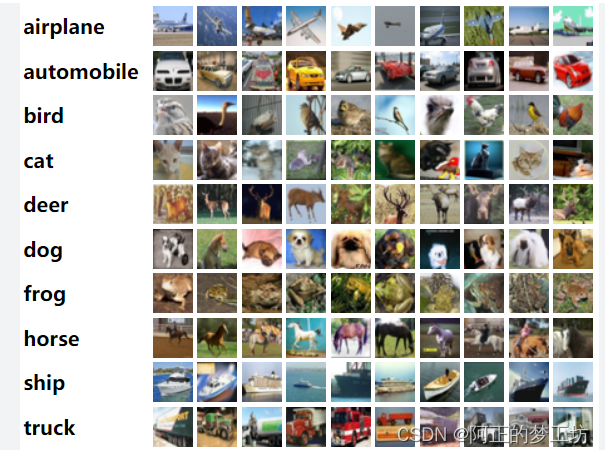预训练和微调代码
数据集:CIFAR10
CIFAR-10数据集由10类32x32的彩色图片组成,一共包含60000张图片,每一类包含6000图片。其中50000张图片作为训练集,10000张图片作为测试集。数据集介绍来自:CIFAR10

图片来源:https://paperswithcode.com/dataset/cifar-10
预训练模型: vgg16
代码
# Imports
import torch
import torchvision
import torch.nn as nn # All neural network modules, nn.Linear, nn.Conv2d, BatchNorm, Loss functions
import torch.optim as optim # For all Optimization algorithms, SGD, Adam, etc.
import torch.nn.functional as F # All functions that don't have any parameters
from torch.utils.data import (
DataLoader,
) # Gives easier dataset managment and creates mini batches
import torchvision.datasets as datasets # Has standard datasets we can import in a nice way
import torchvision.transforms as transforms # Transformations we can perform on our dataset
from tqdm import tqdm
device = torch.device("cuda" if torch.cuda.is_available() else "cpu")
# Hyperparameters
num_classes = 10
learning_rate = 1e-3
batch_size = 1024
num_epochs = 2
class Identity(nn.Module):
def __init__(self):
super(Identity, self).__init__()
def forward(self, x):
return x
# Load pretrain model & modify it
model = torchvision.models.vgg16(weights='DEFAULT')
# # If you want to do finetuning then set requires_grad = False
# # Remove these two lines if you want to train entire model,
# # and only want to load the pretrain weights.
# for param in model.parameters():
# param.requires_grad = False
for param in model.parameters():
param.requires_grad = False
model.avgpool = Identity() # 站位层,使得该层啥事不做
model.classifier = nn.Sequential(nn.Linear(512, 100),
nn.ReLU(),
nn.Linear(100, 10)) # 修改原模型的后几层
model.to(device)
# Load Data
train_dataset = datasets.CIFAR10(
root="dataset/",
train=True,
transform=transforms.ToTensor(),
download=True)
train_loader = DataLoader(dataset=train_dataset, batch_size=batch_size, shuffle=True)
# Loss and optimizer
criterion = nn.CrossEntropyLoss()
optimizer = optim.Adam(model.parameters(), lr=learning_rate)
# Train Network
for epoch in range(num_epochs):
losses = []
for batch_idx, (data, targets) in enumerate(tqdm(train_loader)):
# Get data to cuda if possible
data = data.to(device=device)
targets = targets.to(device=device)
# forward
scores = model(data)
loss = criterion(scores, targets)
losses.append(loss.item())
# backward
optimizer.zero_grad()
loss.backward()
# gradient descent or adam step
optimizer.step()
print(f"Cost at epoch {
epoch} is {
sum(losses)/len(losses):.5f}")
# Check accuracy on training & test to see how good our model
def check_accuracy(loader, model):
if loader.dataset.train:
print("Checking accuracy on training data")
else:
print("Checking accuracy on test data")
num_correct = 0
num_samples = 0
model.eval()
with torch.no_grad():
for x, y in loader:
x = x.to(device=device)
y = y.to(device=device)
scores = model(x)
_, predictions = scores.max(1)
num_correct += (predictions == y).sum()
num_samples += predictions.size(0)
print(
f"Got {
num_correct} / {
num_samples} with accuracy {
float(num_correct)/float(num_samples)*100:.2f}%"
)
model.train()
check_accuracy(train_loader, model)
测试结果
Checking accuracy on training data
Got 29449 / 50000 with accuracy 58.90%
可以看到本次预训练模型的导入,测试结果并不理想。但并不妨碍我们对Pytorch预训练和微调的学习。
参考来源
【1】 https://www.youtube.com/watch?v=qaDe0qQZ5AQ&list=PLhhyoLH6IjfxeoooqP9rhU3HJIAVAJ3Vz&index=8
【2】https://github.com/aladdinpersson/Machine-Learning-Collection/blob/master/ML/Pytorch/Basics/pytorch_pretrain_finetune.py